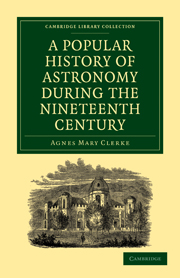Book contents
- Frontmatter
- PREFACE
- Contents
- INTRODUCTION
- Part I PROGRESS OF ASTRONOMY DURING THE FIRST HALF OF THE NINETEENTH CENTURY
- Part II RECENT PROGRESS OF ASTRONOMY
- CHAPTER I FOUNDATION OF ASTRONOMICAL PHYSICS
- CHAPTER II SOLAR OBSERVATIONS AND THEORIES
- CHAPTER III RECENT SOLAR ECLIPSES
- CHAPTER IV SPECTROSCOPIC WORK ON THE SUN
- CHAPTER V TEMPERATURE OF THE SUN
- CHAPTER VI THE SUN'S DISTANCE
- CHAPTER VII PLANETS AND SATELLITES
- CHAPTER VIII PLANETS AND SATELLITES (continued)
- CHAPTER IX THEORIES OF PLANETARY EVOLUTION
- CHAPTER X RECENT COMETS
- CHAPTER XI RECENT COMETS (continued)
- CHAPTER XII STARS AND NEBULÆ
- CHAPTER XIII METHODS OF RESEARCH
- INDEX
CHAPTER II - SOLAR OBSERVATIONS AND THEORIES
Published online by Cambridge University Press: 07 September 2011
- Frontmatter
- PREFACE
- Contents
- INTRODUCTION
- Part I PROGRESS OF ASTRONOMY DURING THE FIRST HALF OF THE NINETEENTH CENTURY
- Part II RECENT PROGRESS OF ASTRONOMY
- CHAPTER I FOUNDATION OF ASTRONOMICAL PHYSICS
- CHAPTER II SOLAR OBSERVATIONS AND THEORIES
- CHAPTER III RECENT SOLAR ECLIPSES
- CHAPTER IV SPECTROSCOPIC WORK ON THE SUN
- CHAPTER V TEMPERATURE OF THE SUN
- CHAPTER VI THE SUN'S DISTANCE
- CHAPTER VII PLANETS AND SATELLITES
- CHAPTER VIII PLANETS AND SATELLITES (continued)
- CHAPTER IX THEORIES OF PLANETARY EVOLUTION
- CHAPTER X RECENT COMETS
- CHAPTER XI RECENT COMETS (continued)
- CHAPTER XII STARS AND NEBULÆ
- CHAPTER XIII METHODS OF RESEARCH
- INDEX
Summary
The zeal with which solar studies have been pursued during the last quarter of a century has already gone far to redeem the neglect of the two preceding ones. Since Schwabe's discovery was published in 1851, observers have multiplied, new facts have been rapidly accumulated, and the previous comparative quiescence of thought on the great subject of the constitution of the sun, has been replaced by a bewildering variety of speculations, conjectures, and more or less justifiable inferences. It is satisfactory to find this novel impulse not only shared, but to a large extent guided, by our countrymen.
William Rutter Dawes, one of many clergymen eminent in astronomy, observed, in 1852, with the help of a solar eyepiece of his own devising, some curious details of spot structure. The umbra–heretofore taken for the darkest part of the spot–was seen to be suffused with a mottled, nebulous illumination, in marked contrast with the striated appearance of the penumbra; while through this “cloudy stratum” a “black opening” permitted the eye to divine further unfathomable depths beyond. The hole thus disclosed–evidently the true nucleus–was found to be present in all considerable, as well as in many small maculæ.
Again, the whirling motions of some of these objects were noticed by him. The remarkable form of one sketched at Wateringbury, in Kent, January 17, 1852, gave him the means of detecting and measuring a rotatory movement of the whole spot round the black nucleus at the rate of 100 degrees in six days.
- Type
- Chapter
- Information
- A Popular History of Astronomy During the Nineteenth Century , pp. 185 - 212Publisher: Cambridge University PressPrint publication year: 2010First published in: 1885



